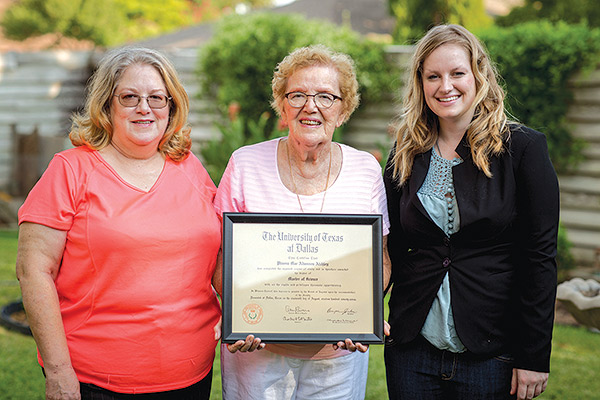
The Atchley family (from left) Dana Atchley Hall BS’80, Phaona Atchley MS’77 and Jenalyn Hall BA’08. Phaona holds the framed diploma of her late husband, John MS’76.
In 1979, Dana Atchley was walking across the UT Dallas campus when she looked down and there, on the sidewalk, was her first driver’s license. She had lost it nine years earlier when she and her sister, Jane, were riding horses in the fields that would eventually become the University’s campus.
Cue the creepy, The Twilight Zone background music.
Anyone else might have taken the find as a sign of cosmic congruence and looked around for Rod Serling to make an appearance. For Dana, it was just a fun coincidence. She is from a family that claims a three-generation legacy of graduates: Dana was attending UTD, her parents had gone to the school to obtain master’s degrees, her future husband would attend and so would their daughter. With her history in the area and with the University, it seemed appropriate that loose ends would weave themselves together on this campus.
For an institution that’s been in existence fewer than 50 years, boasting three generations of graduates from one family is rare.
“Legacies come from the undergraduate experience,” said Dr. Michael Coleman, professor emeritus and UT Dallas dean of the Office of Undergraduate Education from 1997-2010. “As we didn’t begin admitting freshmen until 1990, and it wasn’t until 1996-97 that the freshman class began to grow, very few of that generation have 18-year-olds ready to come to college.”
Coleman was instrumental in the growth of undergraduate admissions. During his tenure, the size of the undergraduate class grew from 564 to 1,343, and the average SAT scores rose as well. In fall 2013, more than 2,200 freshmen enrolled at the University.
The little “think tank” on the prairie (that didn’t even grant degrees) now attracts stellar undergraduates, and not just from the neighboring counties. The word is out, and spreading beyond state and national borders, due in large part to enthusiastic proselytizing by alumni.
UTD began as a graduate-level research institution in 1969. Upper-level undergraduates were admitted in 1975. The first freshmen and sophomores were granted admission in 1990.
UT Dallas Magazine
This article is a version of a longer story that appears in the Fall 2013 edition of the publication with profiles of the Atchley, Citalán and Voit families, all of whom have called UT Dallas home.
Despite the brevity of the University’s existence, there are numerous multigeneration families and an even larger number of families with siblings enrolled in the University. These students do not receive any legacy benefit in admission consideration. Unlike many universities, UT Dallas offers no extra credit for having parents or grandparents who are alumni, not even if the family name is chiseled in a building's stone lintels. Acceptance to UTD is based solely on academic prowess.
Legacy preferences, though, are granted at “almost three-quarters of the top research universities and virtually all elite liberal-art colleges,” wrote Richard D. Kahlenberg, author of Affirmative Action for the Rich: Legacy Preferences in College Admissions.
According to former Wall Street Journal reporter Daniel Golden, the children of alumni make up 10 to 25 percent of the student body at these institutions.
Schools that award preferential treatment give extra points or consideration to legatees. The amount and the way it is calibrated varies, but studies have shown being a lagatee can add the equivalent of 160 points to a candidate’s SAT score, said Thomas Espenshade, a professor of sociology at Princeton and the co-author of No Longer Separate, Not Yet Equal: Race and Class in Elite College Admission and Campus Life. That increases one’s chances of admission to a select university by 19.7 percentage points, according to William Bowen of the Andrew W. Mellon Foundation.
